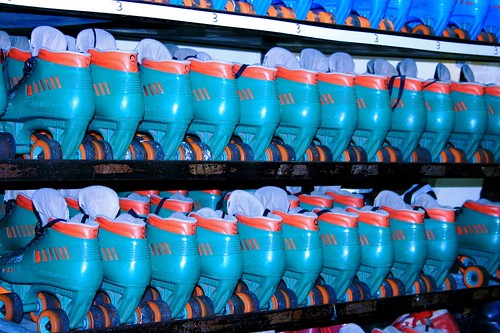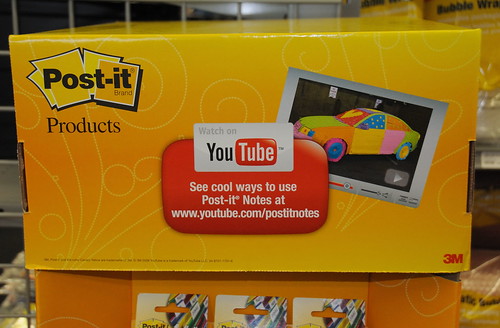On the off chance that anybody is wondering why I haven’t added to my Mad Men Musings series — I wrote about almost every episode of the series in its first season, and not once in its second — it’s mostly because the new season, to me, hasn’t really presented a lot of very interesting material related to commercial persuasion, past v. present. That material has faded into the background of plots I find less interesting (will Don’s wife figure out he’s cheating etc. etc.).
There’s one sort-of-kind-of exception to that, though. This is the subplot involving the hiring of “young” creatives, whose basic value to the agency is their hard-wired understanding of youth culture. There’s clearly a parallel to that going on in the commercial persuasion business today. Aside from experiments like the one the NYT wrote about yesterday (“pop up agency” of twentysomethings created within traditional agency), young people are frequently spoken of by marketers as though they are either members of a different species or, possibly, have arrived here from another planet. The idea is that unless you’re one of “them” you can never never really “get” what makes “them” tick. It’s a bit goofy. Not unlike the professional young people hired by the 1962 ad agency depicted on Mad Men. But there are, I think, some interesting differences. Please continue…
Tomorrow (Thursday) night, I’ll be very briefly in New York for an American Craft Council panel called The Politics of Craft. This is not an advertisement for myself, as the main attractions are Sabrina Gschwandtner, of KnitKnit, and Liz Collins, knitwear designer and founder of Knitting Nation. I expect both will be very interesting and I’m looking forward to meeting them. I’m simply the moderator.
The real reason I bring this up is to apologize in advance to friends in NY: I will not be seeing any of you. I’m literally just there for the night and leaving very early the next morning. So if you happen to hear about this event and wonder why I’m in town without calling, that is the reason. Catch you next time?
UPDATE 9/24: Here is a link to audio recording of this event, if you are curious.
For those of you who read this past weekend’s Consumed about the changing motivations of scrapbookers over time, here’s a follow up: Scrap Smack asks its readers who they scrap for: Do you scrap for relaxation, the creative process, the pure enjoyment of it? Or do you scrap for other reasons? For yourself, for your family, for future generations, for business?”
I scrap for myself, but I must admit when my children drag out their books to show their friends I am proud. I am proud that they want to show their friends what Mommy has done. I am proud when I receive compliments, after all it’s only human to want recognition for a job well done and for talents you may have.
Scrap Smack posts always get a lot of comments, and they’re piling up fast at this one.
Carrie Brownstein says she’s gotten rid of her concert T’s and stickers and posters and the like, and that the faded LP jacket no longer works as a signifier of musical devotion. She writes:
But just because our walls are no longer covered in posters — and our outerwear is free of patches or buttons — that doesn’t mean we don’t want people to know that fandom courses through our veins. And it’s not just fandom we want to prove, but full-on expertise.
These days, we write blogs. We make our iTunes playlist public at the office. (“Dave, I didn’t realize you were such a Yes fan. Every album? Wow! And what’s with all the obscure Brazilian post-punk? Pray tell.”) We use song names in the subject lines of emails and hope the recipient gets the reference. We make mix tapes to be played at parties, we DJ, we download songs as our cell-phone ringtones, and we name our kids after Dylan and Beatles songs. Maybe these things constitute new forms of wear, tear and overuse.
Possibly so. Brownstein goes on to ask her readers for their views on how “we go about proving our love for a band or artist these days.”
But I guess what I see between the lines here is a shift from fandom in the form of devotion to and alliance with a particular artist or artists, to something more like showing off personal taste. A Sleater-Kinney T-shirt just says I like Sleater-Kinney; a playlist filled with obscure stuff you’ve never heard of, including maybe one overlooked/underappreciated Sleater-Kinney gem, says something different. Ideally, if you listen to and like the playlist, then it says I have awesome taste. The goal isn’t to make you a fan of the Sleater-Kinney. It’s to make you a fan of me.
Maybe that’s all obvious. Or equally possible: All wrong.
Just thinking out loud.
Slate‘s new spinoff, The Big Money, launches today, and the Dow is down like 300 points. Coincidence?
Just kidding. Anyway I bring it up because the site has one feature in particular that may be of interest to those of you who follow branding and all that, The YouTube BrandWatch:
Every week, The Big Money features a corporate-themed video that’s had significant viewership on YouTube: some approved, some unapproved, some mashed-up combinations of the two. And we’ll ask our readers to vote on how the video affects the brands.
The first one is here.
 SHARED MEMORIES:
SHARED MEMORIES:
The urge to have your creative talent for recording the past recognized in the here and now
This week in Consumed, a look at scrapbooking, and how scrapbookers’ creations (and their motives) have evolved.
Many of the images reproduced in “Scrapbooks: An American History,” by Jessica Helfand, date back 50, 80, even 100 years. Reproduced in color and spread across wide pages, they are treated as worthy examples of creativity. The anonymous scrapbook creators could hardly have imagined such a fate for their work. Whatever audience they had in mind, it surely did not include a design critic ruminating over this “evocative” and “largely overlooked class of artifact.”
In the 21st century, of course, scrapbooking is a multibillion-dollar affair, with specialty publications and businesses serving a huge market of self-documentarians. By and large, their work has little aesthetic resemblance to what Helfand has compiled. And while contemporary “scrappers” may not be thinking about future historians, a good number are thinking about an audience — and it isn’t just the grandkids. …
Read the column in the September 14, 2008, issue if The New York Times Magazine, or here.
Consumed archive is here, and FAQ is here. The Times’ Consumed RSS feed is here. Consumed Facebook page is here.
To make a point about Consumed that you think readers of The Times Magazine would be interested in: “Letters should be addressed to Letters to the Editor, Magazine, The New York Times, 620 Eighth Avenue, 6th Floor, New York, N.Y. 10018. The e-mail address is magazine@nytimes.com. All letters should include the writer’s name, address and daytime telephone number. We are unable to acknowledge or return unpublished letters. Letters may be edited for length and clarity.”
Save
AdFreak, citing BoingBoing, muses briefly on false memories and branding. One of the cited studies came up briefly in this article (of mine) about brand revival and memory, and in somewhat more detail in the third chapter — if I’m remembering right — of Buying In.
This is the story of how a $24.5 billion multinational corporation refuses to pay a small licensing fee to the amateur photographer who inspired its commercial campaign.
The short version of the allegations is:
In December 2006, somebody covered a car in Post-Its (above), and the images got a lot of Web love.
In spring 2008, 3M got in touch to license the image(s).
Apparently not wanting to pay the requested sum, 3M simply recreated its own version of the idea — Video — to use at point of sale, etc. (Below.)
I’ve done zero reporting on this, so basically I’m simply telling you that All About Content is outraged, and makes this familiar argument about backlash peril:
If you’re a corporate marketer interested in getting into social media marketing, viral video promotion, link bait, etc., I suggest consulting with people who know the communities you’re targeting. Any of us could have told you that stealing photo ideas from the community and using them to pimp your office supplies is not a good move.
So what will the consequences be for 3M? Well, we’ll see.
Thanks: Mystery tipster.
Save
Maybe you’ve seen it, but the WSJ has a story today about “The New Pranksters,” meaning groups like Improv Everywhere. Apart from veteran prankster Joey Skaggs cranky but funny assessment of the trend (“”There’s a lot of junk out there calling itself pranks”), the most interesting thing is the stuff toward the end about advertisers and marketers figuring out how to convert these activities into a commercial persuasion tactic:
Some advertisers are starting to see the marketing value of pranks. Taco Bell recently hired [Improv Everywhere and Urban Prankster founder Charlie] Todd to stage a “freeze” in a new restaurant in Flushing, N.Y., where paid extras posing as employees and patrons simply froze in place, baffling the actual customers. The stunt was later used in a viral marketing campaign for the restaurant’s Frutista Freeze drink, and a video of the prank has been viewed 500,000 times online, says Taco Bell spokesman Will Bortz. “We thought it was brilliant,” he says….
Recently Mr. Todd began accepting corporate sponsorships. In exchange for running a Yahoo logo on the video of his coming MP3 pranks, he says the company is paying him a fee, which he plans to use to hire a production team and possibly stage aerial shots. Mr. Todd says he’ll inform participants about Yahoo’s involvement beforehand. “If I work on a corporate thing, there’s going to be a certain percentage of my fan base who thinks it’s evil,” he says. “It’s been a very difficult thing for me to figure out.”
 * Those of you who follow the links in the sidebar at right, or via the Murketing RSS feed or Delicious, may recall the stories about an Army-themed clothing line launching soon at Sears. Apparently some are not happy about this deal, because some of the clothes will feature the patch of the 1st Infantry Division. Politico quotes one vet saying: “That patch is to be worn by only people who served in the 1st Division. What right does the Army have to sell our patch?” More about the history of the Big Red One patch here. [Thx: Braulio]
* Those of you who follow the links in the sidebar at right, or via the Murketing RSS feed or Delicious, may recall the stories about an Army-themed clothing line launching soon at Sears. Apparently some are not happy about this deal, because some of the clothes will feature the patch of the 1st Infantry Division. Politico quotes one vet saying: “That patch is to be worn by only people who served in the 1st Division. What right does the Army have to sell our patch?” More about the history of the Big Red One patch here. [Thx: Braulio]
* “EtsyBitch is a communal blog of likeminded Etsians who are tired of the demeaning treatment, abuse, and general mismanagement of the Etsy.com site.” [Thx for the tip: Harriete (who I should clarify wasn’t endorsing the blog, I don’t think, just telling me about it.)]
* “Corpoetics is a collection of ‘found’ poetry from the websites of well-known brands and corporations. Nick Asbury has visited various company websites, found the closest thing to a Corporate Overview, and then set about rearranging the words into poetry.” Examples here. [Via Design Observer.]
* The Association of National Advertisers has sent a letter to regulators arguing Google-Yahoo search advertising deal “”will likely diminish competition, increase concentration of market power, limit choices currently available and potentially raise prices to advertisers.”
* Center for Science In The Public Interest going after Sparks. Earlier CSPI went after Spykes, an A-B product that was pulled (not long after being the subject of an April 29, 2007 Consumed).
* Anti-Advertising Agency talks up a documentary called Bomb It, “about the battle for public space between graffiti writers and advertising.”
* Triple backlash special: The Grinder zings an ad by the Corn Refiners Association that’s meant to backlash against anti-high-fructose-syrup sentiments. Got that?
 This looks cool: The Brooklyn Historical Society has an exhibit called Counter/Culture, photos of mom & pop shops around the borough, some of which have since closed, others are still going.
This looks cool: The Brooklyn Historical Society has an exhibit called Counter/Culture, photos of mom & pop shops around the borough, some of which have since closed, others are still going.
At the Society’s site there’s a series of audio files in which the photographers talk about the project and some of the stores.
The exhibit opened yesterday, and runs through December 28. It’s at 128 Pierrepont, corner of Clinton, in Brooklyn (obviously). Hours here.
Via Gothamist, which has more nice pictures from the show, here.




 "
"


 SHARED MEMORIES:
SHARED MEMORIES:

















 Kim Fellner's book
Kim Fellner's book  A
A